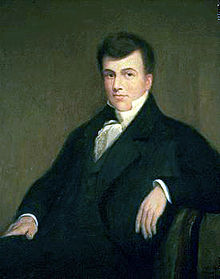Jonathan Jennings
Jonathan Jennings (* 1784 in Readington , Hunterdon County , New Jersey , † July 26, 1834 in Charlestown , Indiana ) was an American politician ( Democratic Republican Party ) and from 1816 to 1822 the first governor of the state of Indiana.
Early years
Jennings' exact date of birth is unknown, but sources assume it was 1784. He was the son of a Presbyterian pastor. In 1790 the family moved to Fayette County , Pennsylvania . In Pennsylvania, he graduated from elementary school and grammar school. In 1806, Jonathan Jennings moved to Jeffersonville , Indiana , where he studied law. After successfully passing his exams and being admitted to the bar, he practiced his new profession in Vincennes from 1807 . However, his work as a lawyer seems to have been limited, as he was soon an employee of the territorial parliament. In 1808 Jennings worked for a short time in the newspaper business. He finally moved to Clark County in 1809 , where he settled in Charlestown.
Political rise
In 1809 he was elected to the US House of Representatives in Washington, DC to represent the Indiana Territory . The choice was fierce and dominated by the issue of slavery . Jennings was an opponent of this institution and managed to win the election against Thomas Randolph, a protégé of William Henry Harrison , the former Territorial Governor. As a result, both Randolph and Harrison were staunch opponents of Jennings. Between November 27, 1809 and December 11, 1816 he represented the Indiana Territory as a delegate in Congress . There he campaigned for Indiana's accession to the United States, emphasizing the prohibition of slavery in the new state. In 1816 he was a member and president of the Indiana Constituent Assembly in advance of its upcoming entry into the Union. Jennings was instrumental in the establishment of the state of Indiana as a slave-free state and in its constitution.
Indiana Governor
Jennings won the first gubernatorial election against the last Territory Governor Thomas Posey . After a successful re-election, he remained in office until September 12, 1822. During this time he continued to campaign against slavery and tried to provide the free black citizens with some legal security with the help of legislation. He founded the state's banking system and laid the foundation for building an education system. In addition, the entire government apparatus had to be built up. In 1818 he concluded peace treaties with three Indian tribes. The construction of an infrastructure was also tackled. In those days that meant: above all the expansion of roads and waterways. Since the tax revenue was insufficient to finance suitable measures, government bonds and state lands were sold. Another problem was the establishment of a new capital. Jennings resided in Corydon , the capital of the Indiana Territory, but during his reign Indianapolis was set as the future capital of the state. Towards the end of his tenure, Indiana was also drawn into the vortex of an economic crisis that went down in US history as the panic of 1819.
Another résumé
After Jennings was re-elected to Congress in 1822, he resigned from his post as governor on September 12, 1822. Until 1831 he represented the interests of his state in Washington. That year he missed re-election, which some historians ascribed to an increasingly worsening alcohol problem. In 1832 he was once again assigned a peacekeeping mission with the Indians in northern Indiana and Michigan . Otherwise he retired to his farm near Charlestown, where he died on July 26, 1834. Jennings had many political opponents throughout his political career, one of whom even wanted to challenge him to a duel. Nevertheless, he was able to lay the foundation for the further development of the state of Indiana.
According to him, Jennings County named in Indiana.
Web links
- Jonathan Jennings in the Biographical Directory of the United States Congress (English)
- Indiana Historical Bureau (English)
- Jonathan Jennings in the database of Find a Grave (English)
| personal data | |
|---|---|
| SURNAME | Jennings, Jonathan |
| BRIEF DESCRIPTION | American politician |
| DATE OF BIRTH | 1784 |
| PLACE OF BIRTH | Readington , Hunterdon County , New Jersey |
| DATE OF DEATH | July 26, 1834 |
| Place of death | Charlestown , Indiana |



